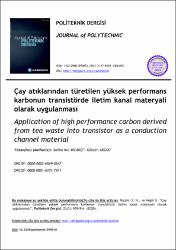Çay atıklarından türetilen yüksek performans karbonun transistörde iletim kanal materyali olarak uygulanması
Künye
Bıçakçı, S.N. & Akgül, G. (2020). Application of High Performance Carbon Derived from Tea Waste into Transistor as a Conduction Channel Material. Journal of Polytechnic-Politeknik Dergisi, 23(3), 909-914. https://doi.org/10.2339/politeknik.599510Özet
Carbon materials are studied in high-tech electronics such as diodes, transistors similar devices. the use of porous carbon materials in electronic devices and their application in energy storage areas are important in terms of developing more economical methods and reducing the dimensions. Although a large number of carbon channel transistors have been reported in the literature in recent years, transistor applications of carbon from biomass as porous carbon are limited. Most of the carbon materials are originated from fossil sources that are diminishing. Renewable carbon resources are gaining importance. Biomass is the only renewable carbon resource. It can be converted to carbonized material called biochar by pyrolysis. However, in order to apply the biochar to carbon-based electrical devices, its structure needs to be improved. in this study, biochar obtained from industrial tea wastes was converted to high performance and n-dopped carbon material by chemical and physical methods. the newly derived carbon material was characterized by SEM, XRD, and FT-IR methods. This formed carbon transistor was used as conduction channel material. the current-voltage (I-V) characteristics of the developed field effect carbon transistor were determined. Faster and more efficient electrical devices can be developed using renewable, sustainable and local biomass resources.


















